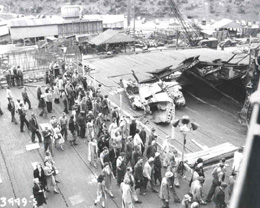In September 1941, the well-established Navy YMCA, located in Bremerton just outside the Puget Sound Navy Yard, becomes a YMCA-USO. During these war years the United Service Organizations (USO) will become part of the community and will play a critical role in maintaining soldier morale. Bremerton welcomes the influx of sailors and helps the service men and women feel at home.
Sailors Far From Home
In 1924, the Navy YMCA had opened in a six-story brick building located just outside the Navy Yard gate at Washington and Front streets. This YMCA had provided for years of recreation and relaxation for sailors in comfortable surroundings.
With the entry of the United States into World War II, and the influx of sailors into Bremerton, the town organized to welcome its new neighbors. For example, on November 25, 1941, the Bremerton Recreation Commission held a Navy dance at the Craven Center and invited local women to attend as dance partners. Also, for Thanksgiving, families were recruited to invite military personnel into their homes for dinner. The same request went out for families to entertain soldiers on Christmas, with the USO coordinating the home visits. Throughout the war years, inviting military personnel into homes became a regular activity in Bremerton.
Friendship and a Little Fun During Wartime
The United Service Organizations (USO) was incorporated on February 4, 1941. It was made up of six agencies: YMCA, YWCA, Salvation Army, Jewish Welfare Bureau, National Catholic Community Services, and Travelers Aid. Early in the war, the agencies had joined together under the name of the United Welfare Committee for Defense. The committee sent President Franklin D. Roosevelt (1882-1945) a telegram requesting a meeting with government officials to present its views. In December the committee met with Paul V. McNutt (1891-1955), head of the Federal Security Agency, whose responsibilities included recreation. Roosevelt in turn directed the Federal Security Agency to work with the welfare committee to come up with an effective program.
President Roosevelt, recognizing the interest of citizen-soldiers to seek civilian recreation, believed that community-based programs could best satisfy this reality. Additionally, providing community recreation centers would reduce the perceived threat of large number of military personnel hanging out with nothing to do. Another advantage would be to enlist local civilian populations, especially women, in the war effort, giving them meaningful functions. The USO was in the position to hire professional staff, and this gave it a tremendous advantage in providing an effective recreational and morale-building organization for service men and women far from home during wartime.
The USO in Bremerton
In late 1941, in Bremerton, soldiers moved into parks and school grounds, and set up tents and air defenses to protect the important Puget Sound Navy Yard. USO morale-boasting operations started. The organization had a significant advantage, attracting excellent staff. Some of the best people from recreation, sports, and social welfare became USO workers.
For example, in Bremerton, on December 13, 1941, Freeda Hartzfield became one of the directors. Hartzfeld (1899-1986), a Columbia University graduate, had been Assistant Dean of Women at Chapman College. She had notable success at the USO and after the war she went to Lewis and Clark College, Portland, Oregon, as Dean of Women, and a highly respected literacy advocate. Today the Freeda Hartzfeld Jones Building on the Lewis and Clark campus honors her.
Ultimately seven USOs served Bremerton's military and industrial (shipyard) workers. The separate industrial clubs operated out of three facilities; two clubhouses in Bremerton and in the Port Orchard housing areas. Since the industrial centers had different emphasis, they were kept distinct from the military clubs, with greater attention to family issues, children's recreation, couples events, and daytime activities to accommodate shift workers.
Dances, Sewing, Reading...
The most popular USOs were the NCCS-run (National Catholic Committee on Scouting) club at 138 Washington Avenue and the Navy YMCA, with its dances drawing large crowds. More than 10,000 servicemen and servicewomen visited the Washington Avenue USO each month.
But each club provided much more than dances. They offered sewing, games, hobby activities, library reading and writing rooms, canteens, and voice letters (records) that soldiers sent home. New arrivals to town received assistance locating housing from the USO-Travelers Aid office.
A women's USO at 522 Burwell Street allowed men only as a woman's accompanying guest. This club provided needed women's services such as discussion groups, baby care lessons, child care, cooking and meal socials, and comfortable sitting rooms. This club allowed servicemen's wives to get out of crowded and often substandard wartime housing for enjoyable social interaction.
Bremerton churches pitched in to serve refreshments at USO events. They would rotate this obligation. Also, the churches put on socials and special events for service men and women. Individual families invited servicemen into their homes, often inviting young women as well to make for a more enjoyable meal and evening.
Attraction and Even Love
Frank Wetzel of Bremerton collected memoirs of the war years in his book Victory Gardens & Barrage Balloons (Bremerton: Perry Publishing, 1997) and they document the central USO role. The memoirs recall the Washington Avenue USO and Craven Center dances as major events. Teddy Green in her recollections spoke of the careful screening of USO hostesses and chaperoned dances.
Jo Peterson told of dancing with a sailor named Merle Spencer at the Women's USO in 1944. They then spent a lot of time together, often going dancing. They fell in love, and married on May 8, 1945, Victory Day in Europe. Although young women USO hostesses were not to leave the club with servicemen or make dates, attraction and love found ways around the rules with a number of marriages resulting.

